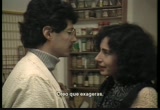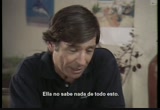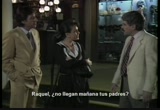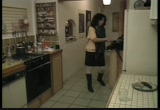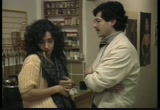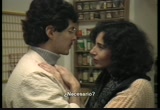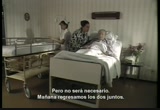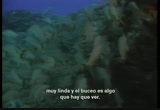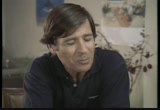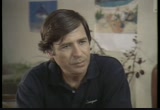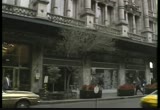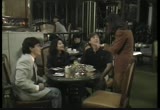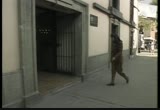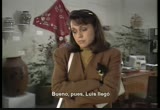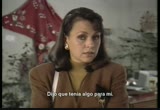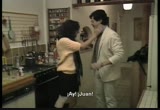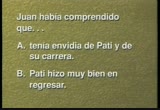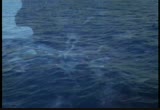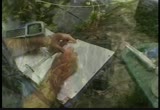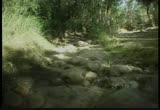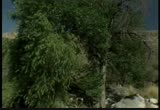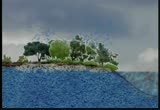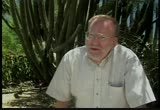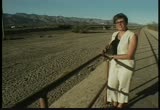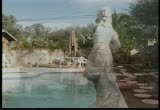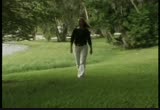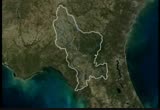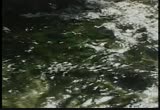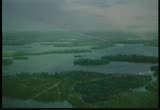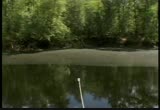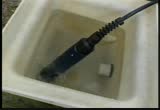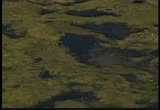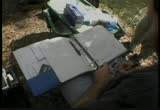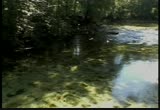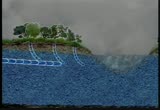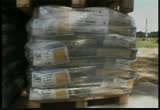tv Democracy Now Special LINKTV October 29, 2012 4:00pm-5:00pm PDT
4:00 pm
annenberg media ♪ provided by: narrador: bienvenidos al episodio 43 de destinos: an introduction to spanish. primero, algunas escenas de este episodio. no puedo dejar de comparar tu vida con la mía. mientras tú tienes una posición estable en la universidad yo no he podido conseguir eso. tú diriges obras de teatro, y yo... escribo artículos que ni siquiera sé si alguien los lee. ¿y raquel? debe estar en su habitación. después la llamo.
4:01 pm
tal vez tenga ganas de salir. bueno. podríamos ir todos a conocer la ciudad. yo hago de guía. iay sí, vamos! pero antes tengo que llamar a puerto rico. mercedes: ianimo, papá! ya verás que pronto estaremos de regreso. mañana, ¿eh? si no mañana, yo mismo me levanto y tomo el avión. sí, ya lo dijiste. pero no será necesario. creo que exageras. parece que la enfermedad de tu padre no te deja ver las cosas con claridad. en este episodio, van a aprender vocabulario y expresiones relacionados con los viajes. me gustaría hacer reservaciones para cuatro personas. ¿para cuándo, señor? para el próximo fin de semana. ihuy! es muy pronto. eh, primero creo que debo de preguntar si hay vacantes. si no hay en el sol caribe vacantes
4:02 pm
las habrá en otro hotel. en cozumel hay muchos hoteles muy buenos además del presidente. ¿el plan incluye el vuelo en avión? sí. el precio incluye viaje de ida y vuelta en avión más tarifas, más impuestos y tres días y tres noches en el hotel. entonces, ¿le hacemos su reservación? sí, pero tengo que consultarlo con una amiga. ella no sabe nada de todo esto. captioning of this program is made possible by the annenberg/cpb project and the geraldine r. dodge foundation. hola, raquel. i¿luis?! sí, raquel, soy yo.
4:03 pm
ivaya sorpresa! en el episodio previo, raquel recibió una sorpresa una sorpresa relacionada con su pasado. durante la cena, arturo observaba a luis y luis también observaba a arturo. vaya. ¿y qué hacías tú en buenos aires? asuntos de trabajo. hacía una investigación. es una larga historia... raquel se encontraba en una situación difícil. gracias, es un regalo de arturo. mientras tanto, juan regresó a nueva york para buscar a pati. pero no la encontró en el apartamento. ilaura! pati estaba trabajando.
4:04 pm
( actores gritan ) iya! iya! iya! muy bien, muy bien. finalmente raquel, arturo y luis salieron del restaurante y regresaron al hotel. ya que don fernando no vuelve hasta pasado mañana tenemos el día libre mañana, ¿no es cierto? es verdad. raquel, ¿no llegan mañana tus padres? con que de argentina, ¿no? sí. fue entonces cuando raquel por fin comprendió por qué luis hizo el viaje a méxico. en su habitación, raquel analizaba la situación mientras arturo y luis hacían lo mismo. ( teléfono suena )
4:05 pm
¿bueno? raquel, ¿estabas dormida? no, luis, todavía no. me gustaría verte ahora, ¿sabes?, a solas. tengo algo para ti. ¿ahora? sí. ¿no te animas? no, luis, disculpa, pero estoy muy cansada. bueno, está bien. pero prométeme que hablaremos mañana... a solas. sí. te lo prometo. hasta luego. adiós. mientras tanto, en nueva york, pati regresa a su casa.
4:06 pm
4:07 pm
¿mucho? pues, sí. y tú a mí, ¿no? bien sabes que sí. ¿cómo van tus asuntos? me alegro de haber regresado. hoy manuel me dijo que si yo no hacía unos cambios la obra no se estrenaría. no tenía idea. ¿y qué piensas hacer? le dije que considerara eso muy bien-- que los periódicos estarían muy interesados en un caso de censura. pati... he estado pensando. ¿sí? no estoy contento con mi carrera... con mi profesión. no puedo dejar de comparar tu vida con la mía. mientras tú tienes una posición estable en la universidad
4:08 pm
yo no he podido conseguir eso. tú diriges obras de teatro, y yo... escribo artículos que ni siquiera sé si alguien los lee. tal vez... tal vez lo que siento es envidia. no siento que soy necesario. ¿necesario? sí, necesario. ¿no ves? tú tenías que regresar a nueva york porque eres necesaria. te necesitaban para continuar con la obra. en cambio, yo... a ti te necesitan en méxico. ¿quién sabe? creo que exageras. parece que la enfermedad de tu padre no te deja ver las cosas con claridad. ¿no crees?
4:09 pm
al día siguiente, en la clínica de la universidad de guadalajara... ianimo, papá! ya verás que pronto estaremos de regreso. mañana, ¿eh? si no mañana, yo mismo me levanto y tomo el avión. sí, ya lo dijiste. pero no será necesario. mañana regresamos los dos juntos. ¿no me vas a dejar aquí sola, verdad? buenos días. buenos días, señor.
4:10 pm
¿qué se le ofrece? estoy pensando en pasar unos días en la playa. muy bien. ud. es argentino, ¿no? sí, soy de buenos aires. estoy aquí por un rato y quería aprovechar un fin de semana para conocer una playa. bueno. sabrá que aquí en méxico hay muchas playas y lugares de vacaciones. cozumel está en el caribe, ¿no? agente: sí, señor. es una pequeña isla, muy linda y el buceo es algo que hay que ver. ¿cuántos irán? seremos dos... no, no seremos cuatro. ¿necesitarán una habitación para cuatro? no. necesitaremos tres habitaciones: una para dos personas, y dos individuales. ¿le interesa cozumel? sí. tenemos diferentes planes. ¿quiere ud. un plan económico? aquí ofrecemos... perdone, pero me gustaría un plan
4:11 pm
que incluya los mejores hoteles. perfectamente, señor. aquí tenemos un plan que incluye el hotel sol caribe. es un hotel de cinco estrellas. en cada habitación tiene baño privado con ducha. todas las habitaciones tienen vista al mar. el hotel tiene canchas de tenis, una piscina muy grande, jardines y playa privada. me parece muy bonito. también está el hotel presidente. también es de cinco estrellas. ¿cuál me recomienda? bueno, yo prefiero el sol caribe. muy bien. me gustaría hacer reservaciones para cuatro personas. ¿para cuándo, señor? para el próximo fin de semana. ihuy! es muy pronto. eh, primero creo que debo de preguntar si hay vacantes. si no hay en el sol caribe vacantes las habrá en otro hotel. en cozumel hay muchos hoteles muy buenos
4:12 pm
además del presidente. sí, felipe gonzález de la oficina de turismo. necesito tres habitaciones para el próximo fin de semana: una doble y dos individuales. ¿cuántas? bien. perfecto. muchas gracias. tiene suerte. hay varias vacantes. ¿y cuánto tiempo piensan quedarse en cozumel? el fin de semana, nada más. ¿el plan incluye el vuelo en avión? sí. el precio incluye viaje de ida y vuelta en avión más tarifas, más impuestos y tres días y tres noches en el hotel. ¿entonces, le hacemos su reservación? sí, pero tengo que consultarlo con una amiga. ella no sabe nada de todo esto. está bien. puede hacer ahora una reservación sin compromiso
4:13 pm
pero la tiene que confirmar mañana a más tardar. muy bien. hablaré con mi amiga esta noche y mañana vengo a confirmar... y pagar. muy bien. su nombre, por favor. arturo iglesias. y los nombres de las otras personas... ah, raquel rodríguez... raquel: les pido a las primeras cien estrellas que veo esta noche que podamos encontrar a angel en puerto rico.
4:14 pm
arturo: yo también les pido lo mismo y que esta persona, esta mujer sea parte importante de mi vida y que yo sea parte importante de su vida también. luis: ¿no te alegras? es un buen trabajo... una gran oportunidad. pero, luis, eso significa que tienes que irte a vivir a nueva york. iclaro! inos vamos a nueva york! yo no puedo, luis. me falta un año para graduarme. yo no puedo irme ahora. pero es que yo tengo que ir. quiero irme. no pienso perder esta oportunidad. sí... entiendo.
4:15 pm
buenos días. buenos días, señor. ¿se le ofrece algo? sí, por favor. quiero hacer reservaciones para dos para ir a zihuatanejo. ¿para cuándo, señor? para este fin de semana... no, digo para el próximo. mmm. ¿cuánto tiempo piensa quedarse? unos dos o tres días nada más. pues, le podemos ofrecer un plan que incluye el hotel las palmas que... ¿no hay unas cabañas? un amigo me habló de unas cabañas en zihuatanejo. ah, sí... las urracas. son ideales para la gente que quiere pasarse unas vacaciones románticas. pues, eso es lo que yo quiero, ¿eh?
4:16 pm
mi amiga no sabe nada de esto. será una sorpresa. cuidado con las sorpresas, ¿eh? ayer estuvo aquí un hombre que tuvo que cancelar su fin de semana en acapulco por no haberlo consultado con su esposa. pero en este caso, no habrá ese problema. bueno. entonces, le hago unas reservaciones para dos personas el próximo fin de semana. las cabañas incluyen un baño privado... su desayuno, señor. gracias. angela: ihola! ibuenos días! ¿qué tal? buenos días. ¿durmieron bien? ihuy, sí! yo estaba cansadísima. dormí como una piedra. yo también dormí muy bien. me siento como nuevo. a los dos les hacía falta descansar.
4:17 pm
¿y raquel? debe estar en su habitación. después la llamo. tal vez tenga ganas de salir. bueno. podríamos ir todos a conocer la ciudad. yo hago de guía. iay sí, vamos! pero antes tengo que llamar a puerto rico. raquel: hola. todos: hola. buenos días. ven a desayunar con nosotros. no, no, siéntate, por favor. tengo que hacer algunas cosas. regreso en seguida. raquel, estábamos planeando ir a conocer la ciudad con roberto como guía. iqué bien! bueno, ahora regreso. todos: mmm. gracias. los señores también van a desayunar. gracias.
4:18 pm
4:19 pm
hay uno a las 9:30 de la mañana que tal vez le convenga. hay muchos asientos disponibles todavía. ¿y cuándo volverán? no estoy segura todavía. en ese caso, se le puede ofrecer un viaje barato. ¿y si regresamos a méxico el lunes? en ese caso se le podría dar un viaje más barato. está bien. tengo parientes en guadalajara, pero quisiera saber qué hoteles me recomienda. quiero uno de los mejores. el hotel camino real es uno de los mejores. ¿qué tipo de habitación prefieren? pues, querríamos tres habitaciones: una habitación doble y dos individuales. está bien, pero para confirmar hay que pagar el 50% de anticipo. está bien. creo que es todo. ¿será muy tarde mañana para confirmar la reservación? en este caso no lo creo. el turismo para guadalajara en este momento está un po flojo.
4:20 pm
pero déjeme revisar los vuelos una vez más. posible que haya a tarifa mejor. ihola! sí, ¿qué tal, tío jaime? sí, raquel me dio tu mensaje. no, mira, lo del apartamento... pues, todavía no hemos hablado. por ahora es mejor quno has nada. sí, de acuerdo, tío. yo también creo que hay que pensarlo mejor antes de decidir. aquí está toda la información. muchas gracias. mañana podré confirmar la reservación o posiblemente esta tarde.
4:21 pm
muy bien. adiós. adiós. bueno, ahora todo parece muy tranquilo pero anoche, ihuy! iqué situación! luis había llegado de los estados unidos y... bueno, pero uds. recuerdan quién es luis, ¿no? es mi ex-novio. bueno, pues, luis llegó y tuve que invitarlo a cenar conmigo y con arturo. imagínense, yo entre estos dos hombres. después, fuimos al hotel y subimos a nuestras habitaciones. yo apenas me había preparado para dormir cuando sonó el teléfono. ¿y quién era? ¿angela, arturo o luis?
4:22 pm
( teléfono suena ) ¿bueno? raquel, ¿estabas dormida? raquel: era luis. no, luis, todavía no. era luis que quería verme. dijo que tenía algo para mí. ¿vi a luis anoche o no? tengo algo para ti. ¿ahora? sí. ¿no te animas? no, luis, disculpa, pero estoy muy cansada. no, no vi a luis. no quise. después de esa cena, estaba yo muy cansada. bueno.
4:23 pm
le prometí verlo hoy. no sé cuándo, pero voy a verlo. mientras en méxico raquel hablaba con luis por teléfono en nueva york, juan esperaba a pati en el apartamento. ¿sabía pati que juan había llegado de méxico o no? iay! ijuan! ime asustaste! perdona. ¿cuándo llegaste? hace como dos horas. pati no sabía que juan había llegado de méxico. juan y pati hablaron de su matrimonio y del futuro.
4:24 pm
no puedo dejar de comparar... durante la conversación, juan dijo algo que él había comprendido en la gavia. ¿recuerdan? ¿qué había comprendido juan? tal vez... tal vez lo que siento es envidia. bueno, había comprendido que tenía envidia de pati y de su carrera. ahora volvamos a raquel. bueno. tengo estos folletos. son de turismo. yo vine aquí esta mañana para pedir información sobre un viaje a guadalajara con mis padres. pero estoy muy enojada con mi mamá por lo de luis.
4:25 pm
4:27 pm
4:30 pm
funding for this program is provided by annenberg media. narrator: 97% of the earth's water is contained in the oceans. some forms of life flourish in this salty environment. but humans require an abundant supply of freshwater. less than 1% of all the earth's water is readily available for human consumption. in the semi-arid desert plains of the southwest united states, where rainfall averages just 2 1/2 centimeters per month, tom maddock studies this scarce resource. dr. maddock: the real problem that we have is that with increasing populations
4:31 pm
and shortages of water, we are becoming very vulnerable. in the southwest, there's a very unique vulnerability here, simply because where do we get the water if there is no water? narrator: across the country in northern florida, the quantity of water isn't an issue. rainfall averages an abundant 1 1/4 meters each year. wendy graham and her colleagues evaluate and model the impacts of industrial and agricultural land use threatening the world's largest collection of freshwater springs. dr. graham: right now, the biggest question is how far we can stress the system and not push it past the point of no return. narrator: both researchers are working towards a sustainable future to protect the water needed by our species and our planet.
4:32 pm
arizona is one of the fastest-growing states in the u.s. the consequent demand on freshwater for personal, industrial, and agricultural use is depleting the natural resource and destroying the environment. i'm tom maddock. i'm at the university of arizona, and i study hydrology. i work in the area of ground-water/surface-water interactions. basically, the difference between ground water and surface water is you can float a stick in surface water. in ground water, you really can't do that except maybe looking down a well and dropping the stick down the well. narrator: surface water is typically found in lakes, rivers, and streams. ground water is found beneath the earth's surface in small pores and fractures found within large rock formations. when this water is readily available for human use, these formations are called aquifers.
4:33 pm
almost all of the natural surface water in arizona has been developed, leaving only ground water available for human consumption. dr. maddock: the problem in the southwest is that we basically are having continued growth, and, in many places, the only place that you can get water to sustain that growth is from ground-water development. unfortunately, ground water is more available near the streams than it is other places. it's what we call the willie sutton principle. willie sutton was a bank robber and was once asked why he robbed banks, and he says, "well, that's because that's where the money is." in the same instance, the wells go in near the river because that's where the water is. but, of course, the ground-water pumping interferes with the surface-water systems. it essentially depletes surface water, and you end up with a conflict. this is a very, very limited quantity of water that you are essentially adding a lot more straws into.
4:34 pm
and ultimately what happens is you run out of water. narrator: pumping a well that's near a stream creates a cone of depression that draws in water from the stream or intercepts water that would have arrived at the stream. as the demand on ground water increases, the level of surface water in streams and rivers decreases. a stream that was once gaining water from aquifers becomes a losing stream until it loses all of its water. dr. maddock: it's a physical problem in terms of the fact that you're taking water out of the stream. it's an ecological problem in the fact that you're reducing habitat for not only plants, but also for birds and animals that may live in that. and thent's an intertionalroblem almost every country in the world that uses ground water as a resource is having troubles with it affecting surface-water systems.
4:35 pm
and it's an area which generally in the past hasn't been studied. narrator: to further understand the effects of water levels on the environment, maddock and his team analyze data gathered from the lush areas surrounding rivers and streams called riparian systems. dr. maddock: basically, very close to the stream, you're gonna find an abundance of trees, like cottonwoods and willows, bushes, grasses, that eventually just disappear as you move further away. and this is called a riparian system. because all the plants are there, the animals and birds habitat that area, too. so, if you reduce that habitat either by dropping a water table or reducing a surface-water supply, essentially what you're doing is destroying not only plant life, but probably animal life, too. and that is the area that i'm trying to understand -- how little water can these systems survive with
4:36 pm
and how they work. narrator: to answer this question, maddock creates mathematical models. dr. maddock: there are certain processes that can only be described mathematically. what we've been able to do is to introduce into ground-water-flow models transpiration processes which reflect the behavior of the plants if you raise and lower the water table. in the past, that hadn't been able to be done. narrator: transpiration is the process in which water vapor is lost from land plants to the atmosphere. this process causes movement of water through the plant from soil to air. water enters a tree through its root system, moves through xylem tissue -- the very thin straws lining the inside of the tree -- before evaporating into the atmosphere through its leaves. dr. maddock: some of the trees in the riparian system can use quite an astounding amount of water.
4:37 pm
it's been estimated that under, say, perfect conditions, a healthy cottonwood can take up as much as 90 gallons per day of water, which is about the same as half of a normal household here in the sohwt. t we're taing aba irly substantial amount of water that's being transpired by the trees. one of the things that had been suggested at e time was perhaps one way to save water in the river is to cut down all the trees along it. the problem is, is when you do that, regular evaporation takes over and you can end up actually losing more water with regular evaporation than you would from transpiration from the trees. there were several studies done by the bureau of reclamation and one by the u.s. geological survey that established this. narrator: to better understand the effects of water depletion in riparian zones, maddock's colleague, dr. kate baird, is measuring the amount of water used by vegetation
4:38 pm
near the san pedro river, a river that has been in decline over the past decade. for each tree, baird determines the volume of water traveling through that tree. to do this, she measures both the velocity of the water moving up the tree and the area of its xylem tissue. dr. baird: so, if i wanted to understand how much water is flowing through the tree or how much water this tree reallyeeded in any day, we would simply peel off a small part of this bark, drill two very small holes into the tree, and insert this heat probe. narrator: a double probe is used to measure the velocity of water moving through the tree. the lower probe is heated to a known temperature. the other measures the temperature of both the tree and water in the tree. if water is not flowing, the upper probe records the maximum-temperature difference possible. the faster the flow of water, the more heat is dissipated,
4:39 pm
and the more the temperature is similar. in this way, researchers can determine the amount of water used by that tree. baird also takes small core samples of the tree to measure the width of the xylem and the total area of xylem in the tree. various trees and plants in a riparian system require different amounts with these data, the team can determine the water needs of the riparian system. what we do is develop a curve that relates the water level to how well the plant transpires, how well it uses the water. and we have three critical points. the first point is called the extinction depth, and that is if the water table drops below that point, the plant will expire. and then if the water table rises, there will be a point at where the plant uses the maximum amount of water. in other words, this is its most efficient point.
4:40 pm
and then as the water table rises even further, what happens is that you can actually end up to the point where you drown the plant, where it has too much water. and one of the things that our researchers do is to try and develop these curves for these plants for these various plant groups, rather than silepecies. , what happens is, is that we may have 5,00species but theyay be able to be grouped in as little as four or five different tys. naator: grouping the trees by such factors as rooting depth, water-level tolerance, and transpiration rate, scientists can detmine the water needs of this ecostem to ensure its future health. dr. baird: the san pedro river is one of the last remaining free-flowing rivers in the semi-aridouthwest. our research is showing that the river is already in declin and possibly at a critical rning point. narrator: if the problem of the san pedro river is ignored,
4:41 pm
it may share the fate of the rillito river, just 160 kilometers away. we're standing along the banks of the rillito river in tucson, arizona, and looking at what happens to a river once it becomes disconnected from the ground water. historically, this dry riverbed had water flowing through it, and lining the banks were cottonwoods and willow and other natural vegetation. years of ground-water pumping for human use have caused the ground-water table to decline, and once the ground-water table declines below the riverbed, the river essentially becomes disconnected and you lose a functioning river. dr. maddock: the trouble is that most people don't understand what the sustainability is in their particular area. if you're lucky enough to have a mixture of surface-water and ground-water systems that you can extract water from to get your water supply, you're in better shape than if you have either one of these and not the other, and the reason for that is,
4:42 pm
is that in wet years when you have lots of war, you can maybe recharge the aquifer. in dry years when you don't have a lot of surface water, you can extract water from the ground-water system. so, there's kind of a sustainable quantity. the primary issue that cities, particularly in the southwest, are having to look at is the idea of sustainability. in other words, how much water does it take to sustain a certain lifestyle, a certain quality of life? narrator: maddock hopes to use his models to educate people about the effects of falling water tables and to help deter overpopulation of these areas in the future. dr. maddock: the research that we're doing on surface-water/ground-water systems is tied in to the management of a regional water supply, which, in turn, is connected to a state or country water supply, which, in turn, is connected into international issues
4:43 pm
involving water supply, so that the things that we study in our area ultimately lead to producing water-management capabilities that are used in other places throughout the world. narrator: while maddock's research is based in the semi-arid southwest, professor wendy graham's research lies across the country in an area where the quantity of water isn't an issue with 50 inches, or 1 1/4 meters, falling annually. but the quality of the freshwater is in danger of being irreparably damaged. northern florida is home to cattle ranches, industrial agriculture, and a human population growing at an unprecedented rate. all of these users have the potential to degrade the abundant water resources that flow here. dr. graham: my name is wendy graham. i'm a professor and director of the water institute at university of florida.
4:44 pm
a very interesting place, hydrologically. there's a lot of freshwater and a lot of people and a lot of land-use changes going on. well, the largest user of water in this region of florida is agriculture. and, in fact, in florida, in general, the largest user of freshwater is agriculture. but public water supply is a close second, and, in the not too distant future, i'm sure will catch up and overtake agriculture as the major user. i grew up in the bahamas. we lived on a little island, and we had our well here, and then we had our septic tank here. and that proximity i always found kind of fascinating. and i'd spent most of my time out of doors. there weren't a lot of indoor distractions -- very few movie theaters, no shopping malls. so we spent our fridays and saturdays on sailboats in the ocean. and then we'd get home to shower, and the water would be off 'cause we only had water from 6:00 a.m. to 2:00 in the afternoon.
4:45 pm
so, we had very limited freshwater and very abundant salt water. and i just got interested in water resources, thinking about that dichotomy. right now, most of the field work i'm involved in is in the suwannee river basin in florida. narrator: a basin is a geographic region that contributes all of its surface water to a river system. this map shows the area from which the suwannee river gets its water. dr. graham: and the suwannee river basin is one of the largest unregulated rivers left in the u.s. it's not interrupted by dams or hydroelectric power. it's just allowed to flow freely in its natural state. and there aren't too many rivers like that left in the u.s. there is a lot of freshwater. the highest concentration of first order springs in the world, it occurs right here in north-central florida. there's a huge reservoir of freshwater
4:46 pm
under the land surface that, even in times of drought, is emerging in the springs and flowing into the rivers. so, we don't get to the point here in this part of the state where we have utilized and overutilized the resource so much. narrator: currently, the suwannee river basin has enough water to sustain the natural ecosystem. but there are ever-increasing temptations to dam and divert the rivers to supply water to other regions in the state. there's a lot of development pressure. there's a lot of competition for those water resources. if people in tampa and miami look up to north-central florida and think, "hmm, you know, "if california can move their water across the state, why don't we go ahead and do that?" so, we are interested in understanding what the requirements of the natural system are and also understanding how major land uses in that basin, particularly agriculture, affect the water quality in the river. narrator: the suwannee river basin
4:47 pm
faces two major obstacles in the future -- increased demand and increased pollution. an average 1,000 people move into the region daily, using freshwater for their homes and septic systems. pollution levels in the basin are also increased when farmers spread fertilizers high in nutrients such as phosphorous and nitrate, on crops for increased yields. the excess fertilizer not used by the crops can be carried to rivers, causing algae and other plants to grow. this can change water quality, rendering it unfit for human consumption. dr. graham's task is to produce mathematical models used to predict how these factors and others work together to determine the health of the ecosystem. with these models, she hopes to avoid some of the mistakes that were made in the past in florida. dr. graham: well, the suwannee river basin in florida
4:48 pm
is relatively undeveloped, as opposed to south florida which was heavily developed in the 1950s after the huge drainage project that basically drained the everglades and created agricultural land and urban lands for people to live on. but 20, 30 years after that process, people started discovering the harm that it was doing to the everglade systems. narrator: over the last 100 years, the everglades have been systematically dammed and pumped for agricultural and urban development. 40% of florida's residents currently live in the area. and crops grown here supply half of the winter vegetables sold in the united states. but the cost to the environment has been astonishing. because of overdevelopment, the flow of freshwater has dramatically decreased, and excess nutrients from farms and ranches have changed the ecosystem to the point where the region is said to be
4:49 pm
on the verge of biological collapse. so, what we would like to do is understand the needs of the natural ecosystem as well as the needs of humans as welas the needs of agriculture so that we don't pass that tipping point and have to spend $8 billion restoring the suwannee river basin like we're having to do in the everglades. narrator: to predict the future of the suwannee river basin, scientists first have to understand how it is presently functioning. dr. john martin is a colleague of professor graham's at the universy of florida water institute. his team studieshe healthof t, sampling and testing its water for signs of pollution. because of sandy soils and the soluble limestone-bedrock geology in this part of florida, rivers here run above ground and then flow underground through sinkholes. above ground, water can be sampled directly.
4:50 pm
but underground, the water fills and moves through the porous rock aquifer. this water can be accessed through a series of wells. the aquifer water here, the water that's contained in the rocks in the very small, microscopic, pore spaces within the rock, is what's utilized for drinking water and, actually, allater, so agriculture-irrigation water, bottling water, any kind of water usage is almost all from ground water. narrator: by carefully measuring the depth of ground water, main's team can calculate how much is being used. 17.29. they also record the water's chemical composition to determine nutrient levels that could adversely affect the health of the water. okay, we're ready to sample. narrator: one key nutrient they sample for is nitrate. actually, nitrate is regulated in drinking water standards by the environmental protection agency. there's been monitoring of the nitrate levels
4:51 pm
in some of the springs around here for decades. and the nitrate levels have been shown to be increasing over that time. narrator: if nitrate levels continue to rise, algae will continue to flourish, creating nets that prevent light from reaching plants living in the water. if these plants are lost, the oxygen they produce will also be lost, resulting in an anoxic environment. this can cause the death of animals and beneficial organisms living in the water, rendering the water unusable for human consumption. this is not natural, the algae. this is all algae that comes from higher nutrient levels than there should be in this water. there shouldn't be any algae growing here at all. i mean, i've never seen it this bad. i mean, this is really kind of disgusting.
4:52 pm
you can see it all along the banks here. nitrate comes from fertilizer, predominantly -- fertilizer and animal waste, including human waste. but there's a lot of agriculture around here, so they fertilize their crops, and it runs off through the surface water into the ground water and then comes out here. you want another one, or is that... the whole area is highly agricultural, so there are cattle feedlots, poultry farms, row crops. the cattle provide animal waste, which are high-nutrient loads, and row crops provide a lot of nitrogen that's not a natural source of nitrogen, through fertilization. moore: human activities basically can degradate the river to the unseen eye, right? to the naked eye, you just look -- it's a pretty river, it flows, it does its thing,
4:53 pm
but what's going on chemically? and just like if you go out today, you can go out there and see the duckweed and the algae, and these are things that historically have not been there. well, basically, what you have happen is if you get too much of a biomass in there, then you can start destroying the water that way. narrator: increased nutrient levels are a concern for water basins worldwide. but the unique geology of the landscape here makes the danger all the greater. the geology of this area is known as karst. below the soil layer lies limestone dissolved by rainwater. this dissolution of rock creates an underground system of caves and porous rocks that allow water and the pollution that it's carrying to move rapidly. flow in karst systems is very rapid because it has these caves or conduits that essentially have infinite permeability. there is no resistance to water flow. dr. graham: and there's very little biological activity
4:54 pm
that would reduce nitrate levels, and that's one of the concerns. if you have a typical riparian zone or a sort of sandy superficial aquifer feeding a river, there's lots of biological activity along the riverbanks. but these springs are just coming out in sort of holes in the rock, and there's no biological remediation that happens. narrator: in a typical water basin, water moves slowly through soil layers containing a vast array of biological organisms that help to remediate excess nutrient loading. but because of the geology of this region, water and dissolved nutrients move quickly to the aquifer with little chance for remediation. and a second feature of this landscape poses an even greater risk. underground caves can collapse, creating sinkholes that are a direct connection between nutrient runoff and drinking water. dr. clark: one of the critical aspects about these direct connections that sinkholes provide between the surface and the aquifer
4:55 pm
is that if there's any kind of pollutants or contaminants that are associated wi that water, that water's now going directly into the aquifer, directly into the ground water. so, it's really these sinkholes are a direct connection between potential contaminants that we might apply to the surface and our drinking water supply. and in the case of nitrates in the ground water, it really has to do with something we're doing up on top of the soil where it may be an inappropriate amount of fertilizer being applied or maybe in a difficult area to try to control that. narrator: the problem of identifying specific sources of pollutants in the basin is complicated. by using data gathered from field research to build computer models, dr. graham and her colleagues can predict overall future trends. wh iclear is that if the population keeps increasing and nutrient levels in the water increase, then the water in the suwannee river basin will not be fit for human consumption.
4:56 pm
however, if land use is changed and pollution levels decrease, graham's models predict more positive outcomes. dr. graham: what we're trying to do with our models is fill the gaps between our observations. when we observe the environment, wee only seeing the conseqnces of what already happened, we have no control over that. sols allow us to take that understanding d project it into the future and provide information to planns and decision makers about how our actions affect water quality and the flow of water through our environment. what i would envision is looking at alternative-irrigation practices, alternative-fertilization practices, alternative-cultural practices that keep most of the nutrients in the root zone, where the plant can use them. on a watershed basis, there are more vulnerable and less vulnerable areas of landscape. if you want to grow corn in your watershed, there will be better places to grow corn
4:57 pm
and worse places to grow corn. if you want this many people in your watershed, there are better places to have urban centers than others. so, i think it'll be a balancing act, but what we hope to do is be able to understand the trade-offs because to have no impact, there would have to be no humans. and there's no optimum solution, but there's a sort of a trade-off curve where, in the end, people have to decide what kind of world they want to live in.
4:58 pm
217 Views
IN COLLECTIONS
LinkTV Television Archive
Television Archive  Television Archive News Search Service
Television Archive News Search Service 
Uploaded by TV Archive on

 Live Music Archive
Live Music Archive Librivox Free Audio
Librivox Free Audio Metropolitan Museum
Metropolitan Museum Cleveland Museum of Art
Cleveland Museum of Art Internet Arcade
Internet Arcade Console Living Room
Console Living Room Books to Borrow
Books to Borrow Open Library
Open Library TV News
TV News Understanding 9/11
Understanding 9/11
